Thikse Monastery
| Thikse | |
|---|---|
 Thikse Monastery | |
 Thikse Monastery Location within Jammu and Kashmir | |
| Coordinates | 34°03′23″N 77°40′00″E / 34.05639°N 77.66667°E |
| Monastery information | |
| Location | Thiksey, Ladakh, Jammu and Kashmir, India |
| Founded | Mid 15th century |
| Date renovated | 1980- new Maitreya Temple added |
| Type | Tibetan Buddhist |
| Sect | Gelug |
| Number of monks | 60 |
| Architecture | Fort monastery in the Central Tibetan pattern. |
Thiksay Gompa or Thiksay Monastery (also transliterated from Ladakhi as Tikse, Tiksey or Thiksey) is a gompa (monastery) affiliated with the Gelug sect of Tibetan Buddhism. It is located on top of a hill in Thiksey village, approximately 19 kilometres (12 mi) east of Leh in Ladakh, India.[1] It is noted for its resemblance to the Potala Palace in Lhasa, Tibet and is the largest gompa in central Ladakh, notably containing a separate set of buildings for female renunciates that has been the source of significant recent building and reorganisation.[2][3]
The monastery is located at an altitude of 3,600 metres (11,800 ft) in the Indus Valley. It is a twelve-story complex and houses many items of Buddhist art such as stupas, statues, thangkas, wall paintings and swords. One of the main points of interest is the Maitreya Temple installed to commemorate the visit of the 14th Dalai Lama to this monastery in 1970; it contains a 15 metres (49 ft) high statue of Maitreya, the largest such statue in Ladakh, covering two stories of the building.[4][5]
History
In the early 15th century, Je Tsongkhapa, the founder of the Gelug School - often called "the Yellow Hats" - sent six of his disciples to remote regions of Tibet to spread the teachings of the new school. Tsongkhapa gave one of his disciples, Jangsem Sherab Zangpo (Wylie: shes rab bzang po ), a small statue of Amitayus (the sambhogakāya form of Amitābha), containing bone powder and a drop of Tsongkhapa's own blood. Tsongkhapa directed him to meet the King of Ladakh with a message seeking his help in the propagation of Buddhism.[6][7]
The King, who was then staying in the Nubra Valley near Shey, loved the gift of the statue. After this meeting, the King directed his minister to help Sherab Zangpo to establish a monastery of the Gelug order in Ladakh. As a result, in 1433, Zangpo founded a small village monastery called Lhakhang Serpo "Yellow Temple" in Stagmo, north of the Indus. In spite of his efforts, the lamas who embraced the Gelug order were initially few, although some of his disciples became eminent figures over the years.[6][7][8][9]
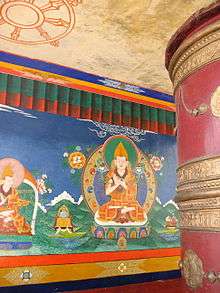
In the mid 15th century, Palden Zangpo continued the monastic work started by his teacher, Sherab Zangpo. He decided to build a larger monastery here that was dictated by an unusual event that occurred while choosing a site. Legends narrate that Tsongkhapa had predicted that his doctrine would prosper on the right bank of the Indus River. This prediction came true when the Thiksey Monastery was established. This was followed by others such as the Spituk and Likir Monasteries, which are also situated on the right bank of the Indus.[2]
According to legend, Sherab Zangpo and Palden Zangpo were performing some sacred rituals near the Yellow Temple. The torma offerings were then taken to a rock outcrop to be thrown down to the valley. As they were about to throw the torma into the valley, two crows appeared suddenly from somewhere and carried away the ceremonial plate with the offering of torma. They then placed the torma at a location on the other side of the hill. When Palden Zangpo and his disciples began looking for the torma, they reached Thiksey, where they found that the crow had placed the torma on a stone in perfect order and in an undisturbed condition. Palden took this finding as a divine directive to build the monastery here.[2][10]
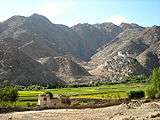

The new Thiksey monastery was located a few kilometres away from Stagmo, on a sacred hill above a village of the same name. The monastery is believed to have been built on the site of an earlier Kadam establishment or as a daughter house of the small chapel of Stagmo about 7 kilometres (4.3 mi) to the north.[10][11] Rinchen Zangpo is also known to have built a temple named Lakhang Nyerma at Thiksey dedicated to the protector Dorje Chenmo. Today, all that can be seen are some ruins.
Thiksey grew in prominence in Ladakh, second only to Hemis Monastery, administering ten other monasteries in the region, such as the Diskit, Spituk, Likir and Stok. The monastery came to own or control 1,327 acres (537 ha) of land and some 25 villages became attached to the monastery.
In around 1770, the lama of Hanle Monastery dictated that his elder son should inherit the throne of Ladakh while other princes should be lamas at Thikse and Spituk. As a result, princes such as Jigsmet Namgyal served as lamas at Thikse.[12]
Modern history

Restoration of the old monasteries in Ladakh, including the Thiksey Monastery, is being carried out by the Archaeological Survey of India, at the request of the concerned Monastery administration. This, however, has not been without its controversy.[13] It is said that the traditional mud and stone courtyards have been changed to granite, which has marred the brightness of the place.[13] Similarly, the restored right wing of the monastery involving construction of new kitchen, the dining hall for the monks by replacing the old traditional central courtyard has caused dissonance to the entire old edifice of the monastery.[13] As a result, a balance to the restoration and renovation works has been sought to retain the old order in consonance with the new works.[13]
Structure
Exterior

Thikse Monastery is the largest such structure in central Ladakh.[14] Located on a hill slope, its building are arranged in an ascending order of importance and are well spaced, from the foot of the hill housing the dwelling units to the top of the hill enshrining the monasteries and potang (official residence) of the chief lama.[14] The architecture of the monastery strongly resembles the Potala Palace in Lhasa, Tibet, the former official seat of the Dalai Lamas.[15] Thus, Thikse Monastery is also known as 'Mini Potala'.[2] The motorable approach road[16] from the valley passes through the east side of the Thikse Monastery's main building. There is statue of the Tibetan protective deity on this path at the entrance at the lower level. The highest level of the complex has a stupa (chorten).[10]
The monastery precinct at the foot of the hill has a courtyard from where a flight of steps leads to the main monastery (one of the 10 temples here), which is 12-stories in height. It has two main chambers. The monastery is painted in red, ochre and white and houses 60 lamas.[17] It has an attached nunnery. Like Likir and Rangdum monasteries, it was built as a fort monastery in the Central Tibetan pattern.[18][19] There are excellent views across the Indus Valley flood plain both east and westbound from it, from which the gompa at Matho (to the east), the royal palace at Stok (across the valley to the south) and the former royal palace at Shey (to the west) are clearly visible.
Maitreya Buddha
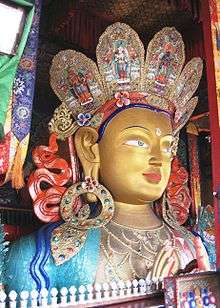
One of the main points of interest is the Maitreya (future Buddha) Temple erected to commemorate visit of the 14th Dalai Lama to this monastery in 1970. It contains a 15 metres (49 ft) high statue of Maitreya Buddha, the largest such statue in Ladakh, covering two storeys of the building.[4] He is unusually portrayed as seated in the lotus position rather than his usual representations as standing or in a sitting posture on a high throne. It is the largest Buddha statue in the monastery, and took four years to build. It was made by the local artists under the master Nawang Tsering of the Central Institute of Buddhist Studies (Leh) - in clay, gold paint and copper.[20][21][22]
Assembly Hall
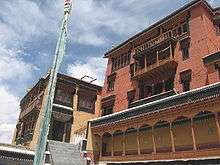
A wall at the entrance to the assembly hall or main prayer hall depicts murals of the Tibetan calendar with the Bhavacakra –the Wheel of Life. This wheel has insignia images of a snake, a bird and a pig that signify ignorance, attachment, and aversion. The purpose of this depiction is meant to remind that these earthly ties need to be overcome in order to get enlightenment in life and to prevent the cycle of death and rebirth.[21]
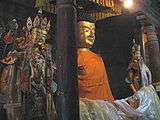
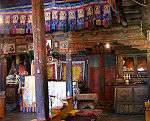
The main prayer room next to this wall has many handwritten and painted books. Behind this prayer hall is the small inner sanctum of the Buddha flanked by Bodhisattvas, Manjushri to the right and Maitreya to the left.[4] The assembly hall also has an image of the 11 headed Avalokitesvara with Padmasambhava. The centre of the assembly hall has a seat for the Dalai Lama and to its right, for the head lama and to its left, another deity is pictured. The hall also has murals of the deities Mahakala and Dukar. 225 volumes of the text Tangyur, wrapped in silk - are stored in wooden shelves in the hall.[4]
Tara temple
A temple is also dedicated to goddess Tara with her 21 images placed in glass-covered wooden shelves.[4] Also, small shrines devoted to several guardian divinities including Cham-spring - the protector deity of Thikse - can also be seen between the main courtyard and the staircase.[4][20][21] The Chi-khang has an image of the Buddha with two of his disciples and the deity Yamantaka.[4] The courtyard mural depicts Tsong Khapa, the Buddha, Padmasambhava, Palden Lhamo and Mahakala.
Lamokhang temple and quarters
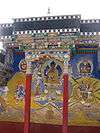
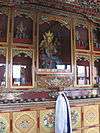

The top floor of the monastery houses the Lamokhang temple, which is a repository of numerous volumes of scriptures including Kangyur and Stangyur. Only men are allowed to enter this floor.[4][20] There are big stupas and mani walls at the entry to the monastery.[10] A small room above the temple is exclusively used as a school room to teach local boys of the villages and some of these boys are chosen as Lamas.[21] The top floor is also the official residence of the incarnate lama of the monastery.[20] A large pillar engraved with the Buddha's teachings is also located here. The monastery complex has a number of white washed huts, which house the Lamas.[23]
Nunnery
The nunnery or the school for the community of nuns is located within the precincts of the monastery and is managed by the Monastery Administration. In Ladakh, nunneries were held in a grossly inferior status and Buddhist nuns in particular lived in appalling conditions.[24] In the 1990s, awareness was raised on the status of the nuns in Ladakh, and Thiksey received a degree of international attention and support.[24] In 1995, the Sakyadhita Conference of Buddhist Women was held in Leh, leading to the establishment of the Ladakh Nuns Association in 1996. This was important in raising the status of the nuns in Ladakh, to ensure a shift in their functional role of “servitude and to one of true spiritual practice”.[24] The Chief Lama, Thiksey Rinpoche of Thiksey Monastery was also important in these positive developments in the betterment of nuns. The monastery donated the land for a new nunnery at Nyerma, near Thiksey, at the same place where the very first monastic seat was established by Rinchen Zangpo, the Tibetan translator, in the tenth century. The nunnery is now under the patronage of Thiksey Monastery.[24]
Today the nunnery houses 26 nuns, ranging from the ages of 43 to 87.[24] The nuns themselves had taken steps to assert their position in the society by changing their traditional name of ‘ani’ (literal meaning “aunt” - a derogatory connotation of a servant) to "cho-mos", the “female religious practitioners”.[24] They even adopted the testament of Mahaprajapati on this issue, expressed by Buddha’s aunt and nun as their anthem.[24] Under the influence of the 14th Dalai Lama’s words, Thiksey Rinpoche Nawang Jamyang Chamba Stanzin and Tsultrim Tharchin, a geshe became nuns’ activists at Thiksey.[24] The Dutch Foundation for Ladakhi Nuns (DFLN), a charitable organisation also operates in Nyerma, providing monetary and individual services to support the Buddhist nuns of Ladakh.[25]
Festivals
The annual festival held in the monastery precincts is known as the Gustor ritual, which is held from the 17th to 19th day of the ninth month of the Tibetan calendar (October–November). Sacred dances such as the mask dance or Cham Dance are performed as a part of this ritual.[20][23][26] Another special feature is the trade fair held at the base of the monastery, in which villagers from all over Ladakh assemble to barter and trade items and socialize.[27] Sand mandalas are made for smaller festivals.[23] The morning prayers at 7 am, with synchronized chanting of the Buddhist sūtras at this monastery, attract many worshippers to observe the services.[2][23]
Notes
- ↑ Singh (2006), p.91
- 1 2 3 4 5 "Thicksey Monastery". Retrieved 2009-12-04.
- ↑ Willis, Jan. "The Cho-mos of Ladakh: From Servants to Practitioners". Buddhadharma: The Practitioner's Quarterly. Retrieved 29 September 2014.
- 1 2 3 4 5 6 7 8 Bhasin, Sanjeev Kumar (2006-01-01). Amazing land Ladakh: places, people, and culture. Indus Publishing. p. 106. ISBN 978-81-7387-186-3.
- ↑ Bandhu, Desh (1997). Thiksey Monastery. Thiksey Monastery. Indus Publishing. p. 112. ISBN 9788173870699. Retrieved 2009-12-04.
- 1 2 Malik, Abdul Hamid (1984). Ladakh Region. Thiksey. Gazetteers Dep., Gov. of Jammu and Kashmir. p. 87. Retrieved 2009-12-04.
- 1 2 Jina, p.319-320
- ↑ Rizvi, pp. 231-232
- ↑ "Thicksey Monastery". Retrieved 2009-12-04.
- 1 2 3 4 Jina, p.320
- ↑ Rizvi (1996), pp. 231-232
- ↑ H. N. Kaul (1992-01-01). Ladakh through the ages, towards a new identity. Indus Publishing. pp. 58, 61. ISBN 978-81-85182-75-9.
- 1 2 3 4 Outlook (2008). Outlook 3 November 2008. Broken Hemisphere:Touch of Synthetic. Outlook Publishing. pp. 28–29. Retrieved 2009-12-04.
- 1 2 Graetz, Stéphanie de Windisch-; Ghislaine de Windisch-Graetz (1982). Himalayan kingdoms: gods, people & the arts. Roli Books International. Retrieved 2009-12-04.
- ↑ Kaur, p.94
- ↑ Bhasin (2006), p.106
- ↑ "Handa (1987), p. 149">Handa (1987), p. 149
- ↑ "Handa (1987), p. 149"
- ↑ Handa (1987), p. 149
- 1 2 3 4 5 "Thiksey Monastery, J&K". Retrieved 2009-12-02.
- 1 2 3 4 "Thiksey Gompa". Retrieved 2009-12-04.
- ↑ Prem Singh Jina (1997). Recent researches on the Himalaya. Indus Publishing. pp. 118–9, 202. ISBN 978-81-7387-069-9.
- 1 2 3 4 Bindoloss, Joe; Sarina Singh (2007). India. Thiksey Monastery. Lonely Planet. pp. 381–382. ISBN 9781741043082. Retrieved 2009-12-04.
- 1 2 3 4 5 6 7 8 Jan Willis (2004). "The Cho-mos of Ladakh: From Servants to Practitioners". Buddhadharma: The Practitioners Quarterly. Retrieved 2009-12-04.
- ↑ "News Letter Spring 2005". Dutch Foundation for Ladakhi Nuns. Archived from the original on February 1, 2009. Retrieved 2009-12-04.
- ↑ "Thiksey Gompa". Retrieved 2009-12-02.
- ↑ "Thiksey Festival". Retrieved 2009-12-04.
References
| Wikimedia Commons has media related to Thiksey Monastery. |
- Bhasin, Sanjeev Kumar (2006). Amazing Land Ladakh: Places, People, and Culture. Indus Publishing. ISBN 81-7387-186-8.
- Jina, P. S. (2006). Ladakh Himalaya: past and present. Thiksey Monastery. Anmol Publications Pvt. Ltd. pp. 316, 319–347. ISBN 9788126125791. Retrieved 2009-12-04.
- Handa, O. C. (1987). Buddhist Monasteries in Himachal Pradesh. Indus Publishing Company, New Delhi. ISBN 81-85182-03-5.
- Kaur, S. Ladakh Mountains Of Adventure. Children's Book Trust. ISBN 81-7011-979-0.
- Rizvi, J. (1996). Ladakh: Crossroads of High Asia. 2nd Edition. Oxford University Press. ISBN 0-19-564546-4.
- Singh, Lipika (2006). The World of Buddhism, Volume 2. Shubhi Publications. ISBN 81-8290-048-4.
Coordinates: 34°03′23″N 77°40′00″E / 34.05639°N 77.66667°E